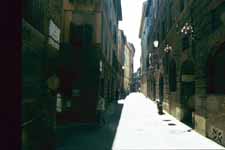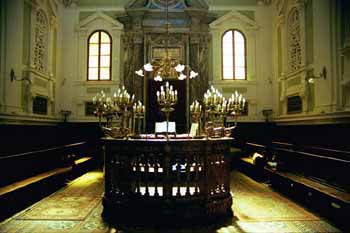Virtual Jewish World: Siena, Italy
Located in the Chianti Hills, Siena is known for its rich artistic heritage and unchanged medieval churches and architecture. The city was founded by the Etruscans, colonized by the Romans and ruled by various other leaders, including the Medicis. Siena is divided into three parts, San Martino, Citta and Camolia, named after the three hills it is built upon. One of Siena’s most exciting and well-known events is the Palio, an annual horse race that is run within the main square of the city.
 |
By 1229, a Jewish community had been established in Siena whose main source of livelihood was moneylending.
In1348, Jews were blamed for the plague and were forced to live outside the city center.
In 1335, Vitale di Daniele received permission to open a bank in the town and the Jewish banking business continued to thrive for the next 350 years.
Jews experienced a period of relative tranquility during the 15th century, despite the attacks delivered by Franciscan friars during their sermons. A piece of anti-Jewish legislation was passed in 1439, forcing all Jews, except for bankers to wear an "O" on their clothing. In 1441, a special judge was put in charge for trying cases dealing with Jews and Jewish matters; this was looked upon favorably by the community. Jews were also given permission to live and do business in the city center. In 1457, Jews were authorized to act as moneylenders. Jews were also given complete religious freedom.
In the 16th century, the great Jewish banker Ishmael da Rieti lived and worked in Siena. He was visited by many Jewish scholars and rabbis. Jews also attended the University of Siena during the 16th century, and, between 1543-1600, at least 11 Jews graduated as physicians from the University.
In 1555, anti-Jewish measure were also enacted in Siena. In 1571, Duke Cosimo I wanted to receive the title of grand duke, so he followed the wishes of the church and established the Sienese ghetto. All Jews had to live in the ghetto, wear a yellow cap (men) or scarf (women) and the community had to pay a special tax. Despite the restrictions and taxes, Jews continued to prosper in the ghetto and study at the University of Siena.
 |
More anti-Jewish legislation was passed and Jews were forbidden to be involved in banking, employ Christian workers and were forced to sell only second-hand merchandise.
The restrictions were eased by the end of the 18th century. In 1786, a new synagogue was built in Siena. Jews were given full emancipation in March 1799, when Napoleon’s troops occupied the town. In June 1799, however, rioters from Arezzo ransacked and burned the ghetto, killing 19 Jews. This event is commemorated, by a fast every year by the Jews of Siena. Following the violence, many Jews left Siena and the size of the community decreased from 500 (18th century) to 300 (19th century) to 200 (beginning of 20th century). The ghetto existed until 1859 and was partially destroyed in 1935. All that remains are some street signs.
In the 19th century, Siena was home to many famous scholars, including Menachem Azaria Castelnuovo (a Kabbalist), Samuele Nissim, Samuele Cabibbe, Angelo Paggi and Dante Lattes, a scholar during World War I.
Not much remains of the Jewish community of Siena. In 1968, it numbered only 100 people.
Jewish Tourist Sites
Synagogue
The synagogue was designed by Giuseppe del Rosso in 1786. Inside there are a number of rare fabrics called "Indians," as well as Jewish ritual items of the Guadagni family. Outside the synagogue, there is a plaque on the left side commemorating the deportees of World War II and another plaque of the right side remembering those who died in World War I.
Via degli Archi (ghetto fountain)
Located opposite the synagogue, this fountain was famous throughout the ghetto.
Il Campo delli Hebrei (Jewish cemetery outside the San Viene Gateway)
Jews have been buried at this cemetery for many years, documents dating from 1661 reveal the Jews were buried there for a long time. This large cemetery is still in use and seems to be Siena’s only Jewish cemetery.
Sources: "Siena." Encyclopedia Judaica. CD-ROM edition
"The Synagogue of Siena."
Tuscany Jewish Itineraries: Place, History and Art. Edited by Dora liscia Bemporad and Anna Marcela Tedeschi Falco.Marsilio Publisher 1997.
Photo credits: Copyright © Mitchell Bard, map Copyright © Traveleurope Italy.



